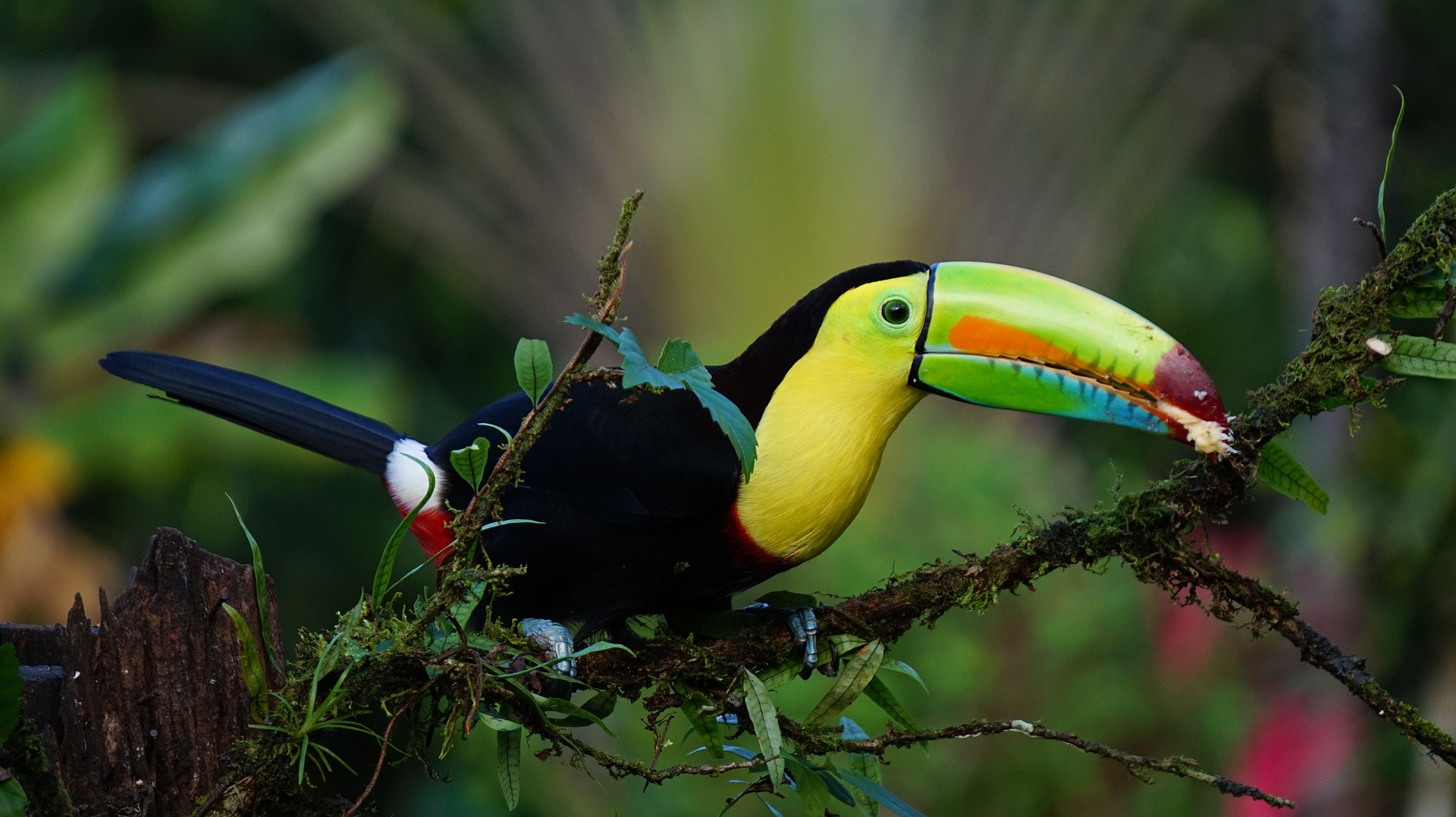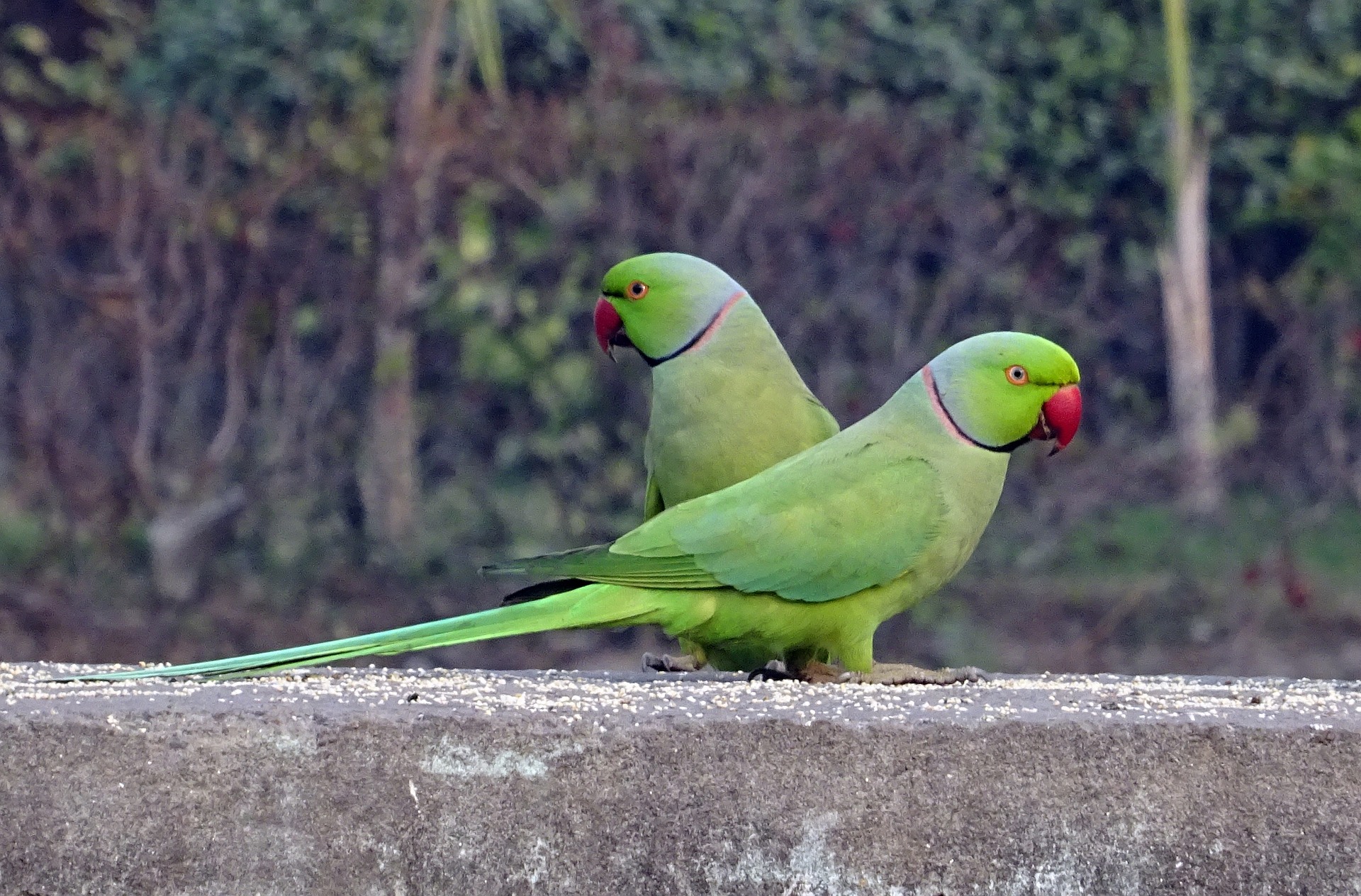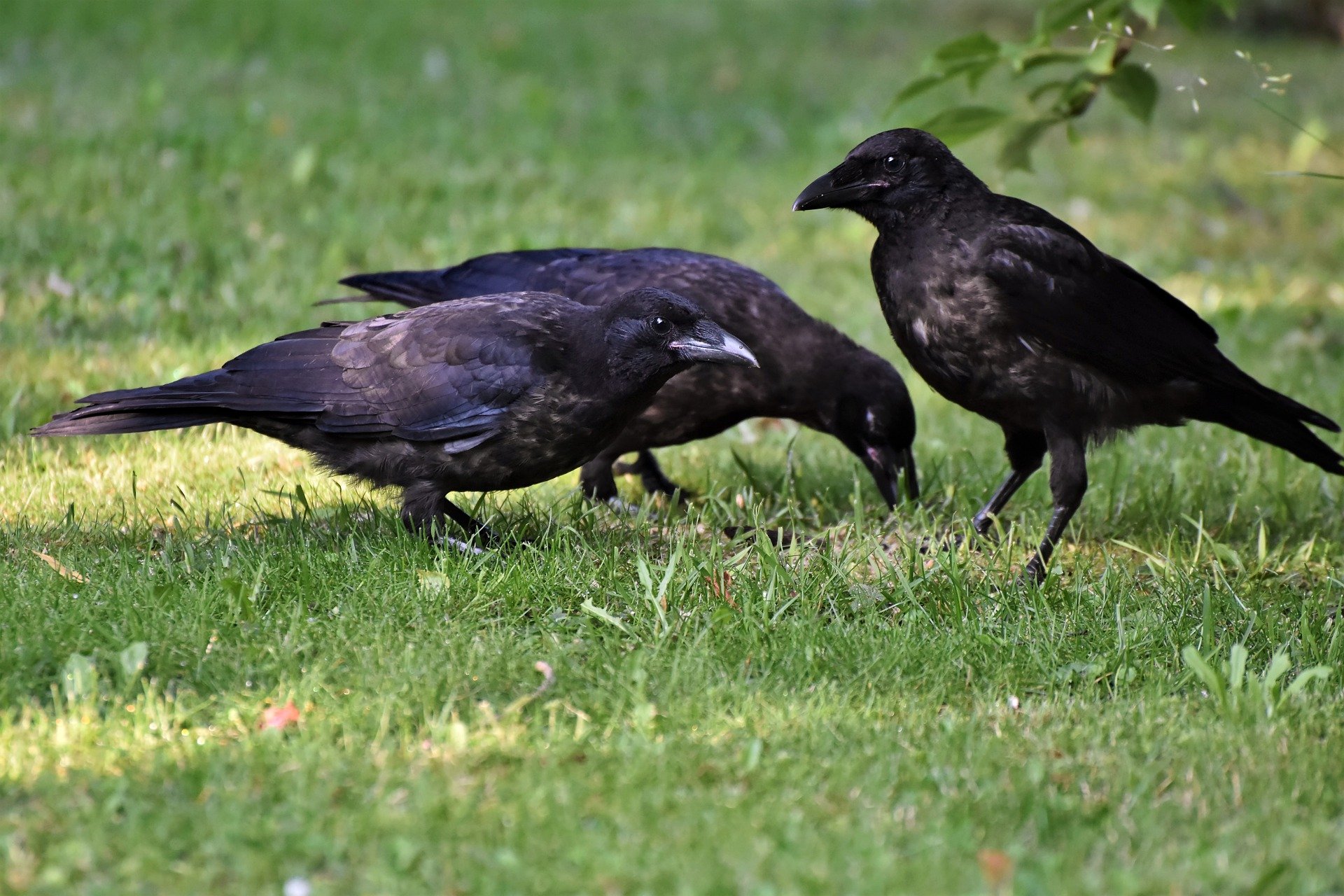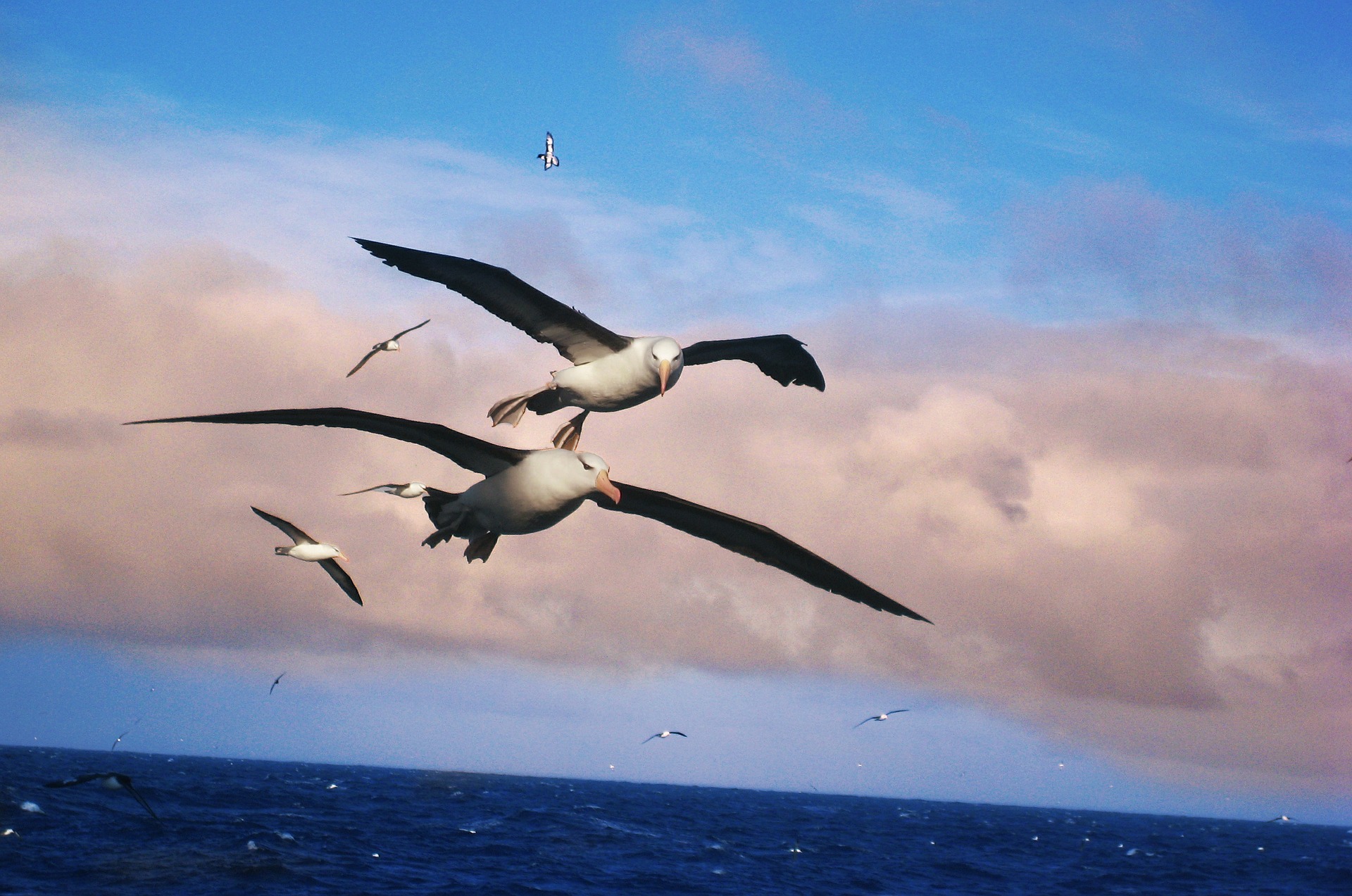Welcome to Birds Gallery

Toucan Bird
Ramphastos sp.
Toucans range in size from the lettered aracari (Pteroglossus inscriptus), at 130 g (4.6 oz) and
29 cm (11 in), to the toco toucan (Ramphastos toco), at 680 g (1.50 lb) and 63 cm (25 in). Their bodies
are short (of comparable size to a crow's) and compact. The tail is rounded and varies in length, from
half the length to the whole length of the body. The neck is short and thick. The wings are small, as
they are forest-dwelling birds who only need to travel short distances, and are often of about the same
span as the bill-tip-to-tail-tip measurements of the bird.However, the bills of female toucans are
usually shorter, deeper and sometimes straighter, giving more of a "blocky" impression compared to male
bills. The feathers in the genus containing the largest toucans are generally purple, with touches of
white, yellow, and scarlet, and black. The underparts of the araçaris (smaller toucans) are yellow,
crossed by one or more black or red bands. The toucanets have mostly green plumage with blue markings.
◉ Toucans are native to the Neotropics, from Southern Mexico, through Central America, into South
America south to northern Argentina. They mostly live in the lowland tropics, but the mountain species from the
genus Andigena reach temperate climates at high altitudes in the Andes and can be found up to the tree line.
◉ Toucans are primarily frugivorous (fruit eating), but are opportunistically omnivorous and will
take prey such as insects, smaller birds, and small lizards. Captive toucans have been reported to hunt insects
actively in their cages, and it is possible to keep toucans on an insect-only diet. They also plunder nests of
smaller birds, taking eggs and nestlings. This probably provides a crucial addition of protein to their diet.
Certainly, apart from being systematically predatory as well as frugivorous, like many omnivorous birds, they
particularly prefer animal food for feeding their chicks. However, in their range, toucans are the dominant
frugivores, and as such, play an extremely important ecological role as vectors for seed dispersal of fruiting
trees.

Kingfisher
Alcedo atthis
The smallest species of kingfisher is the African dwarf kingfisher (Ispidina lecontei), which ave&rages
10 cm (3.9 in) in length and between 9 and 12 g (0.32 and 0.42 oz) in weight. The largest kingfisher in
Africa is the giant kingfisher (Megaceryle maxima), which is 42 to 46 cm (17 to 18 in) in length and
255–426 g (9.0–15.0 oz) in weight. The familiar Australian kingfisher known as the laughing kookaburra
(Dacelo novaeguineae) is the heaviest species with females reaching nearly 500 grams (18 oz) in
weight.The plumage of most kingfishers is bright, with green and blue being the most common colours. The
brightness of the colours is neither the product of iridescence (except in the American kingfishers) or
pigments, but is instead caused by the structure of the feathers, which causes scattering of blue light
(the Tyndall effect).In most species, no overt differences between the sexes exist; when differences
occur, they are quite small (less than 10%).
The kingfishers have long, dagger-like bills. The bill is usually longer and more compressed in species
that hunt fish, and shorter and more broad in species that hunt prey off the ground. The largest and
most atypical bill is that of the shovel-billed kookaburra, which is used to dig through the forest
floor in search of prey. They generally have short legs, although species that feed on the ground have
longer tarsi. Most species have four toes, three of which are forward-pointing.
◉ The kingfishers have a cosmopolitan distribution, occurring throughout the world's tropical and
temperate regions. They are absent from the polar regions and some of the world's driest deserts. A number of
species have reached islands groups, particularly those in the south and east Pacific Ocean. The Old World
tropics and Australasia are the core areas for this group. Europe and North America north of Mexico are very
poorly represented, with only one common kingfisher (common kingfisher and belted kingfisher, respectively), and
a couple of uncommon or very local species each: (ringed kingfisher and green kingfisher in the southwestern
United States, pied kingfisher and white-throated kingfisher in southeastern Europe). The six species occurring
in the Americas are four closely related green kingfishers in the genus Chloroceryle and two large crested
kingfishers in the genus Megaceryle. Even tropical South America has only five species plus the wintering belted
kingfisher. In comparison, the African country of the Gambia has eight resident species in its 120-by-20-mile
(193 by 32 km) area.
◉ Kingfishers feed on a wide variety of prey. They are most famous for hunting and eating fish,
and some species do specialise in catching fish, but other species take crustaceans, frogs and other amphibians,
annelid worms, molluscs, insects, spiders, centipedes, reptiles (including snakes), and even birds and mammals.
Individual species may specialise in a few items or take a wide variety of prey, and for species with large
global distributions, different populations may have different diets. Woodland and forest kingfishers take
mainly insects, particularly grasshoppers, whereas the water kingfishers are more specialised in taking fish.
The red-backed kingfisher has been observed hammering into the mud nests of fairy martins to feed on their
nestlings. Kingfishers usually hunt from an exposed perch; when a prey item is observed, the kingfisher swoops
down to snatch it, then returns to the perch. Kingfishers of all three families beat larger prey on a perch to
kill the prey and to dislodge or break protective spines and bones. Having beaten the prey, it is manipulated
and then swallowed.Sometimes, a pellet of bones, scales and other indigestible debris is coughed up.The
shovel-billed kookaburra uses its massive, wide bill as a shovel to dig for worms in soft mud.
Albatross
Phoebastria sp.,
Phoebetria sp.
Albatrosses, of the biological family Diomedeidae, are large seabirds related to the
procellariids, storm petrels, and diving petrels in the order Procellariiformes (the tubenoses). They
range widely in the Southern Ocean and the North Pacific. They are absent from the North Atlantic,
although fossil remains show they once occurred there and occasional vagrants are found. Albatrosses are
among the largest of flying birds, and species of the genus Diomedea (great albatrosses) have the
longest wingspans of any extant birds, reaching up to 3.7 m (12 ft). The albatrosses are usually
regarded as falling into four genera, but disagreement exists over the number of species.
◉ Most Albatrosses range in the Southern Hemisphere from Antarctica to Australia, South Africa, and
South America. The exceptions to this are the four North Pacific albatrosses, of which three occur exclusively
in the North Pacific, from Hawaii to Japan, California, and Alaska; and one, the waved albatross, breeds in the
Galápagos Islands and feeds off the coast of South America. The need for wind to enable gliding is the reason
albatrosses are for the most part confined to higher latitudes; being unsuited to sustained flapping flight
makes crossing the doldrums extremely difficult. The exception, the waved albatross, is able to live in the
equatorial waters around the Galápagos Islands because of the cool waters of the Humboldt Current and the
resulting winds.
◉The albatross diet is predominantly cephalopods, fish, crustaceans, and offal
(organ meat), although they also scavenge carrion and feed on other zooplankton.For most species, a
comprehensive understanding of diet is known for only the breeding season, when the albatrosses regularly return
to land and study is possible. The importance of each of these food sources varies from species to species, and
even from population to population; some concentrate on squid alone, others take more krill or fish.[26] Of the
two albatross species found in Hawaii, one, the black-footed albatross, takes mostly fish, while the Laysan
feeds on squid.Until recently, albatrosses were thought to be predominantly surface feeders, swimming at the
surface and snapping up squid and fish pushed to the surface by currents, predators, or death. The deployment of
capillary depth recorders, which record the maximum dive depth undertaken by a bird, has shown that while some
species, such as the wandering albatross, do not dive deeper than a metre, some species, such as the
light-mantled albatross, have a mean diving depth of almost 5 m (16 ft) and can dive as deep as 12.5 m (41 ft).
In addition to surface feeding and diving, they have also been observed plunge diving from the air to snatch
prey.
They feed on squid, fish, and krill by either scavenging, surface seizing, or diving. Albatrosses are colonial,
nesting for the most part on remote oceanic islands, often with several species nesting together.

Parrot
Psittacoidea sp.
Parrots, also known as psittacines are birds of the roughly 398 species in 92
genera comprising the order Psittaciformes , found mostly in tropical and subtropical regions. The order
is subdivided into three superfamilies: the Psittacoidea ("true" parrots), the Cacatuoidea (cockatoos),
and the Strigopoidea (New Zealand parrots). One-third of all parrot species are threatened by
extinction, with higher aggregate extinction risk (IUCN Red List Index) than any other comparable bird
group. Parrots have a generally pantropical distribution with several species inhabiting temperate
regions in the Southern Hemisphere, as well. The greatest diversity of parrots is in South America and
Australasia.Characteristic features of parrots include a strong, curved bill, an upright stance, strong
legs, and clawed zygodactyl feet. Many parrots are vividly coloured, and some are multi-coloured. Most
parrots exhibit little or no sexual dimorphism in the visual spectrum. They form the most variably sized
bird order in terms of length.
Parrots, along with ravens, crows, jays, and magpies, are among the most intelligent birds, and the
ability of some species to imitate human speech enhances their popularity as pets. Trapping wild parrots
for the pet trade, as well as hunting, habitat loss, and competition from invasive species, has
diminished wild populations, with parrots being subjected to more exploitation than any other group of
birds. Measures taken to conserve the habitats of some high-profile charismatic species have also
protected many of the less charismatic species living in the same ecosystems.
◉Parrots are found on all tropical and subtropical continents and regions including Australia and
Oceania, South Asia, Southeast Asia, Central America, South America, and Africa. Some Caribbean and Pacific
islands are home to endemic species. By far the greatest number of parrot species come from Australasia and
South America. The lories and lorikeets range from Sulawesi and the Philippines in the north to Australia and
across the Pacific as far as French Polynesia, with the greatest diversity being found in and around New Guinea.
The subfamily Arinae encompasses all the neotropical parrots, including the amazons, macaws, and conures, and
ranges from northern Mexico and the Bahamas to Tierra del Fuego in the southern tip of South America. The pygmy
parrots, tribe Micropsittini, form a small genus restricted to New Guinea and the Solomon Islands. The
superfamily Strigopoidea contains three living species of aberrant parrots from New Zealand. The broad-tailed
parrots, subfamily Platycercinae, are restricted to Australia, New Zealand, and the Pacific islands as far
eastwards as Fiji. The true parrot superfamily, Psittacoidea, includes a range of species from Australia and New
Guinea to South Asia and Africa. The centre of cockatoo biodiversity is Australia and New Guinea, although some
species reach the Solomon Islands (and one formerly occurred in New Caledonia), Wallacea and the Philippines.
◉ The diet of parrots consists of seeds, fruit, nectar, pollen, buds, and sometimes arthropods and
other animal prey. The most important of these for most true parrots and cockatoos are seeds; the large and
powerful bill has evolved to open and consume tough seeds. All true parrots, except the Pesquet's parrot, employ
the same method to obtain the seed from the husk; the seed is held between the mandibles and the lower mandible
crushes the husk, whereupon the seed is rotated in the bill and the remaining husk is removed. They may use
their foot sometimes to hold large seeds in place. Parrots are granivores rather than seed dispersers, and in
many cases where they are seen consuming fruit, they are only eating the fruit to get at the seed. As seeds
often have poisons that protect them, parrots carefully remove seed coats and other chemically defended fruit
parts prior to ingestion. Many species in the Americas, Africa, and Papua New Guinea consume clay, which
releases minerals and absorbs toxic compounds from the gut.

Common Raven
Corvus corax
The common raven (Corvus corax), also known as the western raven or northern raven when
discussing the raven at the subspecies level, is a large all-black passerine bird. Found across the
Northern Hemisphere, it is the most widely distributed of all corvids. There are at least eight
subspecies with little variation in appearance, although recent research has demonstrated significant
genetic differences among populations from various regions. It is one of the two largest corvids,
alongside the thick-billed raven, and is possibly the heaviest passerine bird; at maturity, the common
raven averages 63 centimetres (25 inches) in length and 1.2 kilograms (2.6 pounds) in mass. Although
their typical lifespan is considerably shorter, common ravens can live more than 23 years in the
wild,which among passerines only is surpassed by a few Australian species such as the satin bowerbird
and probably the lyrebirds. Young birds may travel in flocks but later mate for life, with each mated
pair defending a territory.
◉ The common raven can thrive in varied climates; indeed this species has the largest range of any
member of the genus,and one of the largest of any passerine. They range throughout the Holarctic from Arctic and
temperate habitats in North America and Eurasia to the deserts of North Africa, and to islands in the Pacific
Ocean. In the British Isles, they are more common in Scotland, Wales, northern England and the west of Ireland.
In Tibet, they have been recorded at altitudes up to 5,000 m (16,400 ft), and as high as 6,350 m (20,600 ft) on
Mount Everest. The population sometimes known as the Punjab raven—described as Corvus corax laurencei (also
spelt lawrencii or laurencii) by Allan Octavian Hume but more often considered synonymous with subcorax is
restricted to the Sindh district of Pakistan and adjoining regions of northwestern India.They are generally
resident within their range for the whole year. In his 1950 work, Grønlands Fugle [Birds of Greenland], noted
ornithologist Finn Salomonsen indicated that common ravens did not overwinter in the Arctic. However, in Arctic
Canada and Alaska, they are found year-round.Young birds may disperse locally
In the United Kingdom, the common raven's range has been increasing, though it favours mountainous or coastal
terrain, but can also be found in parks with tall trees suitable for use as habitation. Its population is at its
most dense in the north and west of the country, though the species is expanding its population southwards.
◉ Common ravens are omnivorous and highly opportunistic: their diet may vary widely with location,
season and serendipity. For example, those foraging on tundra on the Arctic North Slope of Alaska obtained about
half their energy needs from predation, mainly of microtine rodents, and half by scavenging, mainly of caribou
and ptarmigan carcasses.In some places they are mainly scavengers, feeding on carrion as well as the associated
maggots and carrion beetles. With large-bodied carrion, which they are not equipped to tear through as well as
birds such as hook-billed vultures, they must wait for the prey to be torn open by another predator or flayed by
other means. Plant food includes cereal grains, berries and fruit. They prey on small invertebrates, amphibians,
reptiles, small mammals and birds. Ravens may also consume the undigested portions of animal feces, and human
food waste. They store surplus food items, especially those containing fat, and will learn to hide such food out
of the sight of other common ravens. Ravens also raid the food caches of other species, such as the Arctic fox.
They sometimes associate with another canine, the grey wolf, as a kleptoparasite, following to scavenge
wolf-kills in winter. Ravens are regular predators at bird nests, brazenly picking off eggs, nestlings and
sometimes adult birds when they spot an opportunity. They are considered perhaps the primary natural threat to
the nesting success of the critically endangered California condor, since they readily take condor eggs and are
very common in the areas where the species is being re-introduced. On the other hand, when they defend their own
adjacent nests, they may incidentally benefit condors since they chase golden eagles out of the area that may
otherwise prey upon larger nestling and fledging condors. Condors, despite their large size, do not seem to have
well developed nest defenses.




